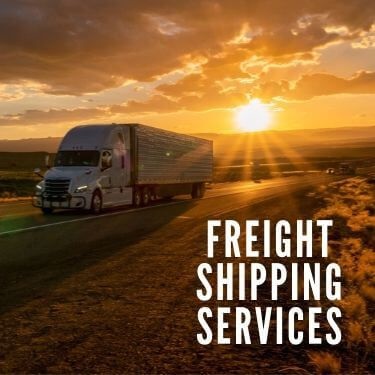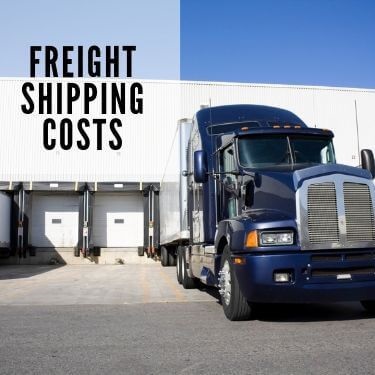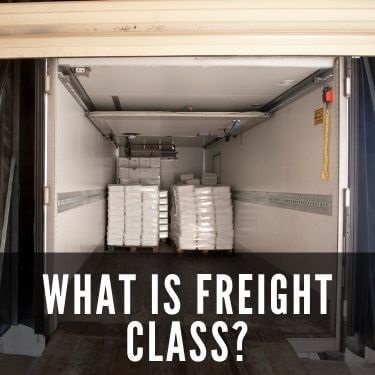Freight shipping has become such an integral part of the supply chain that is is almost impossible to run a business now without shipping something out for consumption across the U.S. American consumers have become accustomed to having a variety of different products to choose from at any given time, from anywhere in the U.S. This is especially true with agriculture, where some produce just will not grow in some parts of the country. However, if you’re new to the process of freight shipping, getting your product around the U.S. can seem like a daunting task.
There are several options available for freight shipping services, like FTL, LTL, and intermodal. Shippers select the option that best suits their needs depending on many factors, like when and where the freight needs to arrive, what the budget is, and how large the shipment is.
There are many different freight services available, so each shipment can be customized according to their individual needs and specifications. Some commodities would not fit on a standard freight truck, and would, therefore, require a different type of truck. Perishable shipments, like food or plants, must be kept at a specific temperature to avoid premature spoilage. Even the budget and time the shipper has can determine which method of shipping they choose for their freight.
Freight services include shipping options like:

Those terms might not mean much to you yet, so let’s explore what each of those options are in more detail.
Almost any commodity can move via freight, even sweets! Learn more about freight shipping confections!
FTL stands for “Full Truckload,” while LTL stands for “Less than Truckload.” Although those terms appear self-explanatory, there is a lot more to know about them than meets the eye.
First of all, an FTL freight shipment means that the amount of freight being shipped can fill up an entire freight truck on its own, thus being a full truckload. A standard indicator of whether or not a shipment will need an entire truck is if it contains more than 10 pallets, or if it weighs more than 15,000 pounds. Generally, it is a more expensive option when compared with LTL shipping, but it is not without its perks.
There are many benefits to using FTL shipping, even if a shipment is relatively small. Because the freight would not need to share the truck with any other loads, the truck can move right from the point of departure to the point of delivery without making any unnecessary stops to drop off freight. This means that the freight will get to its destination a lot faster. Along those same lines, it completely erases the possibility of the freight being unloaded at the wrong location or damaged from being handled too much.
An LTL freight shipment means that the freight cannot fill up the entire truck, and thus is packed with other LTL shipments moving in the same direction. It is a lot more cost-effective than FTL, but it comes with more risks that could make it worth it to get a full truck regardless of the size of the load. LTL shipments need to make many stops to unload and separate the different shipments that may be going to different places. This means that the freight is handled much more, which increases the chances of all or part of the shipment getting lost, misplaced, or damaged.
As long as a shipper is willing to take those risks, and wait a little longer for their load, then they could save quite a bit of money by going with LTL shipping.
The most important things to consider when trying to decide between FTL and LTL are:
Most freight trucks for both FTL and LTL shipping are what are known as dry vans. They are the most common mode of freight transportation, and they do not include any special features. They are large and versatile, capable of moving anything from clothing to workout equipment, and can keep the shipment safe from bad weather, theft, and any other damage. However, they do not have any temperature control capabilities, and they cannot accommodate anything that does not fit within the boundaries of their container.
If the shipment that needs to be moved contains perishable or temperature-sensitive products, then a regular dry van will not suffice. On a hot summer day, the inside of a dry van can reach sweltering conditions. If the shipment inside is a perishable food, that would render it inedible and unsellable. Likewise, winters in the north can wreak havoc on fragile shipments like flowers and plants, which would wither when exposed to the cold. A specially insulated temperature-controlled truck is required to ensure that these products reach their destination in good condition.
Almost all temperature-controlled trucks must be FTL, to ensure that the temperature inside the container can be maintained. Any time the container is opened, it makes it harder to keep the temperature inside the container what it needs to be, making LTL shipping of temperature-sensitive freight downright impractical.
Flatbed trucks are very different from dry vans and temperature-controlled trucks. Unlike those two, a flatbed is simply an open platform attached to the back of the truck to stack freight on top of, with no sides or top. It is commonly used for freight that is too large for an enclosed truck, irregularly shaped, or not sensitive to damages from the weather. Common things that are shipped on flatbed trucks include building materials, landscaping materials like trees and other plants, and heavy equipment like farm plows or military vehicles.
If you have an oversized shipment and need heavy haul trucking rates, R+L Global Logistics can help you. We have long-standing relationships with reliable and experienced heavy haul carriers. Our established network allows to provide you a quick and affordable quote when you need a heavy haul trucking company.
Expedited shipping is a method of transportation that ensures that freight will be delivered faster than the standard shipping time. This means that a package that would ordinarily take four days for delivery could be expedited to only two days. Overnight and same-day shipping can even bring some transit times down to only a single day or less.
Expedited shipping can be achieved on any type of truck within a reasonable margin, with priority handling and teams of drivers to move nonstop until the freight reaches its destination.
Intermodal freight shipping is a method of transportation that involves more than one type of freight mode, which is most commonly trucks and rails. Freight will be loaded onto a dry van and taken to a rail, it will be loaded onto a railcar. From there, the freight would move most of the distance along the rail, before it is finally loaded onto another dry van to complete the last few miles of the delivery.
Intermodal shipping seems like a hassle with all the extra steps involved, but there are actually many good reasons to consider making use of it. For one thing, trains use a lot less fuel than regular trucks, which can really reduce the cost of shipping. In addition to being a cheaper option, intermodal delivery times can be more reliable than traditional truckload shipping. Although it is not as fast, it is not affected by traffic, changing weather conditions, or human error, so it will always arrive exactly when it is expected. It also remains one of the most popular options for shipping freight into Canada and Mexico.
Freight shipping rates are often determined by a number of different factors. No single shipment is going to cost the same as any other shipment, even if most of the factors remain consistent. This is because some factors that cannot be controlled, like the time of year or the weather, can impact what the final cost is.
In order to get an idea of what the freight rate will end up being, consider the various factors that influence the cost of shipping:

Additionally, LTL freight carriers specifically base their rates on the freight class of the specific commodity being shipped, although they also use the factors listed above to come up with a price quote.
Freight classification is a standardized method of determining the overall cost of moving a certain shipment for LTL freight specifically. The code assigned to a shipment is the best indicator of how much the shipment will cost to move, based on the value and type of commodities, and other details.
The National Motor Freight Traffic Association (NMFTA) is a non-profit organization that is responsible for the creation and maintenance of the National Motor Freight Classification (NMFC) system. This system categorizes different shipments with a freight class number system. All the codes in the system fall between 50 and 500, and there are 18 possible variations that could be applied to a shipment. The lower the number associated with a shipment, the lower the cost of moving it will be. Likewise, if the number is higher, then the shipment will be more expensive to move.

There are four main factors to consider in order to determine the freight class of a specific shipment:
The density of the product being shipped is an important factor to consider when determining how much it will cost to move. Density is measured in pounds per cubic foot and is determined by measuring the dimensions of a unit, like a crate or a pallet, and comparing that to its weight. If a product takes up a lot of space on a truck but is relatively lightweight, like ping pong balls, then it’s going to cost more to move it in order to make it worth the carrier’s time.
Stowability describes how the product can fit inside the truck. Determining factors include whether or not it can stack or be stacked on, if it is flammable, and if it is regulated by a government agency. Whether or not it can be positioned next to other different commodities can also help determine how easy it is to stow. If freight is hazardous or perishable, there will be additional rules in place for regulating how it is shipped, and will, therefore, cause it to be more expensive.
Ease of handling is another important indicator of how much it will cost to move a specific shipment. If a shipment is fragile, dangerous, or cumbersome, then it will cost much more to ship than something that is easy to pack and move. Certain products that are large and heavy, or cannot be palletized or boxed, can provide serious challenges for the workers that pack and unpack the trucks. Because of the additional effort involved for the carrier, they are going to charge more to compensate. If the shipment is lightweight and packaged well, the freight class and subsequent cost are going to be a lot lower.
Carriers do not want to be liable for damages to a high-value shipment that could cost them loads of money. If a particular commodity is expensive, fragile, or likely to be stolen, the freight will cost more to ship. Additionally, if the commodity is likely to be harmful or dangerous to the other commodities around it, then the freight class will be even higher to include liability compensation on behalf of those commodities as well.
The process of freight shipping is complicated. There are many things to keep in mind when trying to organize the transportation of goods, and there’s a lot that could go wrong. When your customers are waiting on you, the last thing you need is for your freight to arrive late—or worse, damaged. That’s one of the reasons to rely on the expertise of a third-party logistics company, or 3PL, like R+L Global Logistics.
Working with R+L Global Logistics can ensure that you get a qualified carrier to deliver your freight from California to Florida and other states safely and on time. We can also provide accurate freight quotes for any type of freight shipping (everything from milk to grapes, musical instruments, and more), help you determine the freight class of your shipment, and handle all communication with the carriers on your behalf. If this beginner’s guide to freight shipping doesn’t answer all your questions, contact us and we will be happy to answer any questions you may still have.

R+L Global Logistics
315 NE 14th St., Ocala, FL 34470